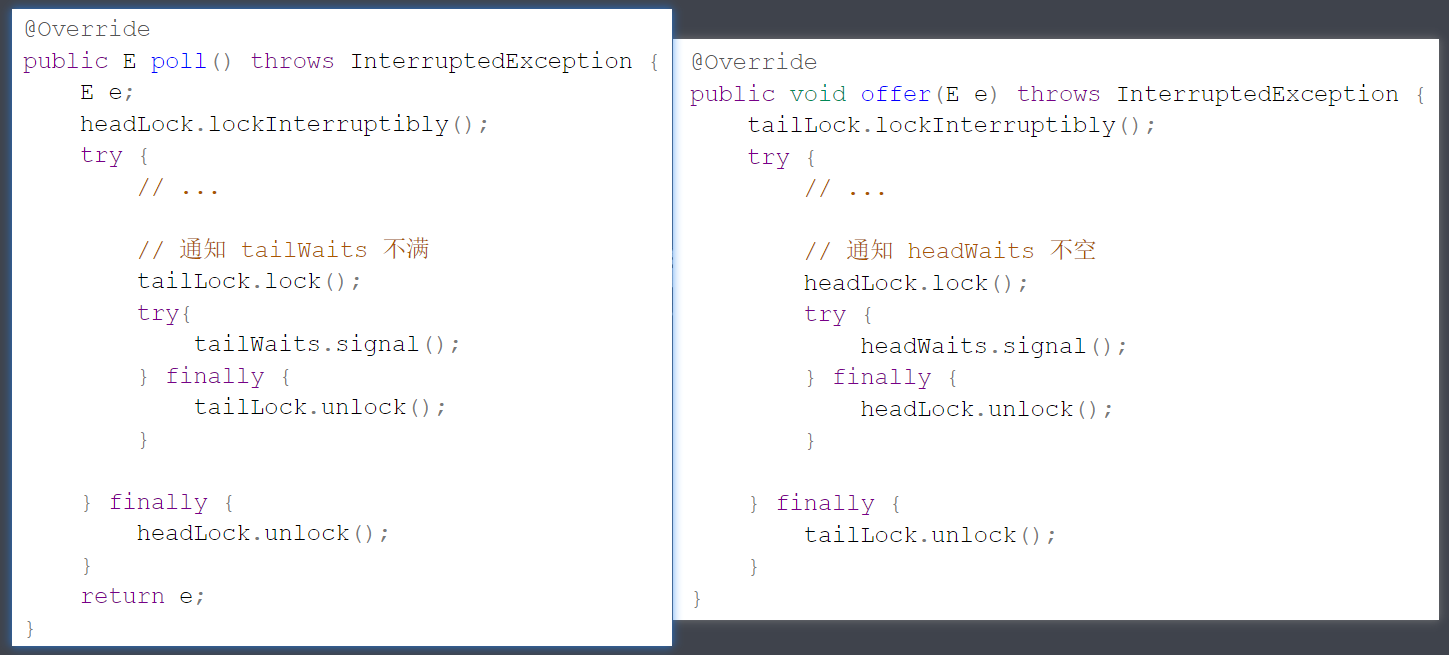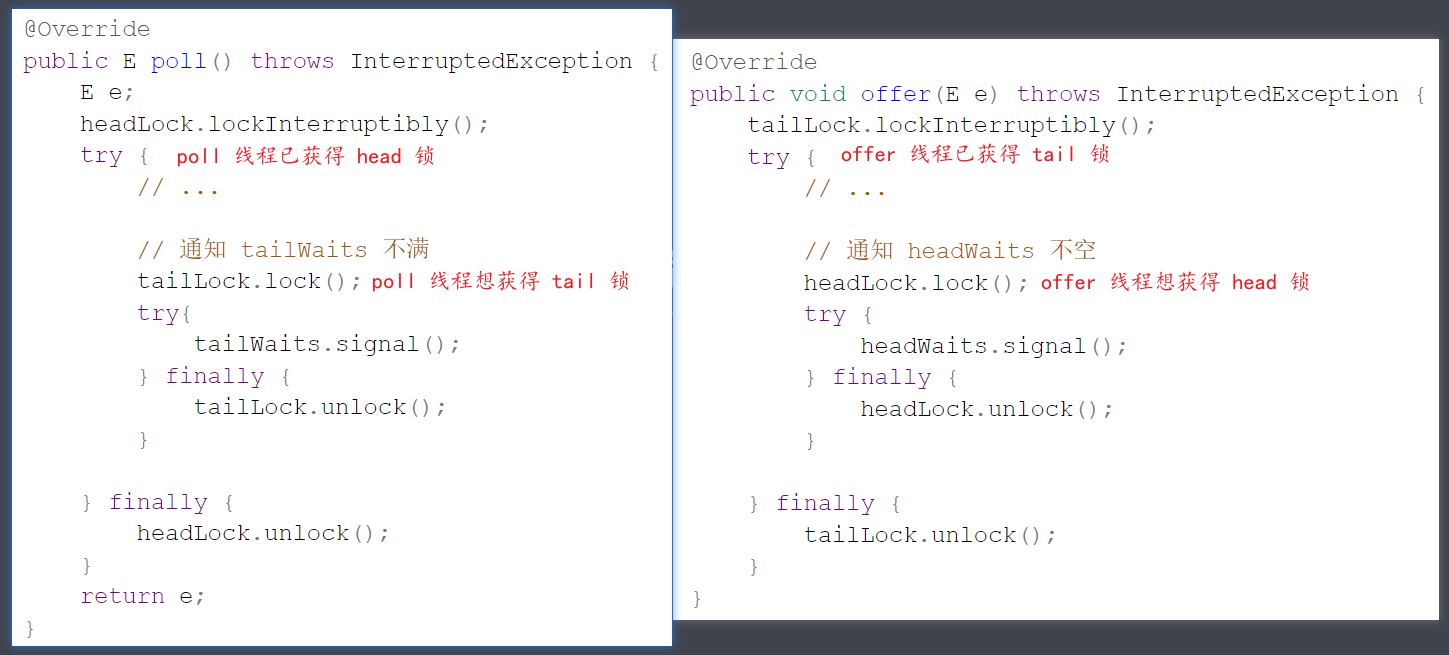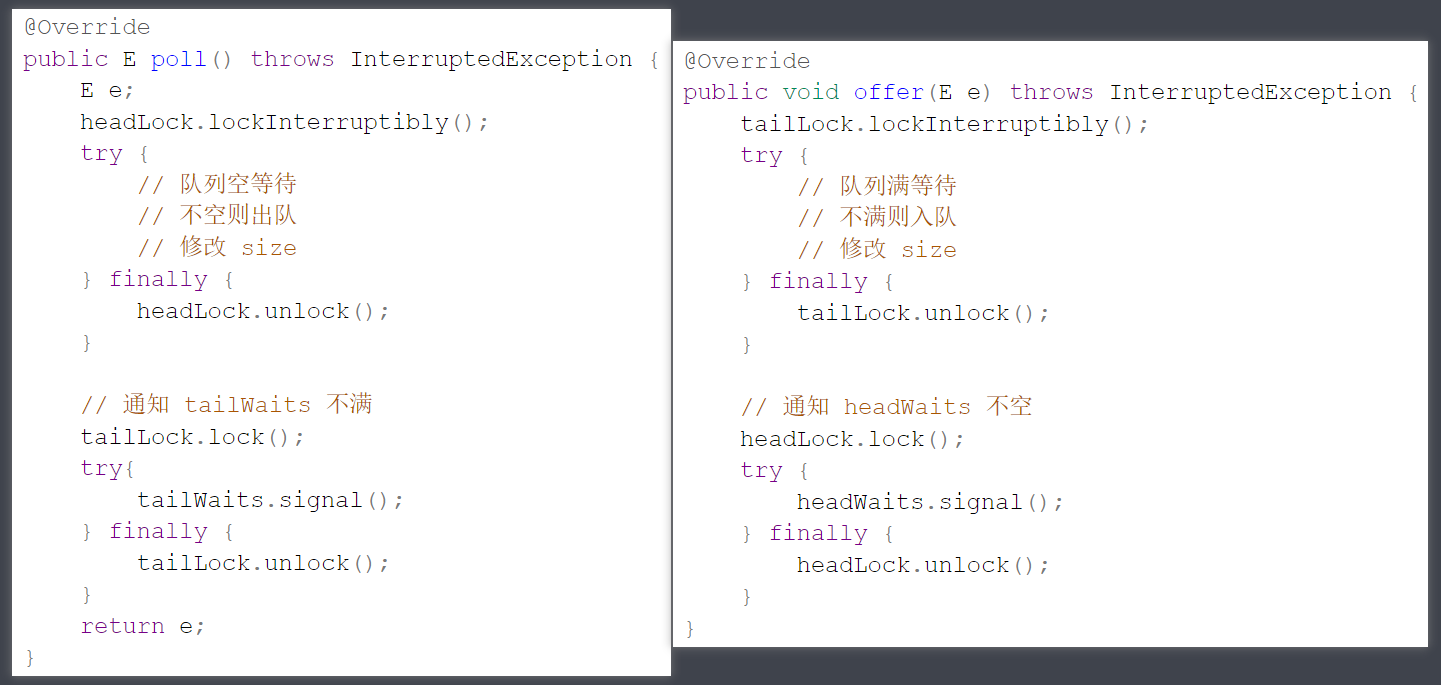# 一.阻塞队列简介
# 1.什么是阻塞队列
阻塞队列(Blocking Queue)是一种常见的线程同步工具,通常用于多线程编程中,用于在生产者和消费者之间安全地传递数据。阻塞队列的主要特点是当队列为空时,消费者会被阻塞直到有数据可用;当队列已满时,生产者会被阻塞直到有足够的空间来存储数据。这种行为确保了线程之间的协同和数据的安全传递。
# 2.阻塞队列常用的方法
阻塞队列通常提供以下基本操作:
put():用于将数据放入队列,如果队列已满,它将阻塞等待直到有空间可用。take():用于从队列中取出数据,如果队列为空,它将阻塞等待直到有数据可用。offer():与put()类似,用于将数据放入队列,但不会阻塞线程,如果队列已满,它会返回 false。poll():与take()类似,用于从队列中取出数据,但不会阻塞线程,如果队列为空,它会返回 null 或指定的默认值。
阻塞队列的使用场景包括线程池、任务调度、生产者-消费者问题等。通过使用阻塞队列,可以有效地管理多线程之间的数据交换,避免了手动编写复杂的同步机制,提高了多线程编程的可维护性和可靠性。在 Java 中,java.util.concurrent包提供了一些常见的阻塞队列实现,如ArrayBlockingQueue和LinkedBlockingQueue等。其他编程语言和平台也提供了类似的实现或库。
# 3.等待问题
之前的队列在很多场景下都不能很好地工作,例如
- 大部分场景要求分离向队列放入(生产者)、从队列拿出(消费者)两个角色、它们得由不同的线程来担当,而之前的实现根本没有考虑线程安全问题
- 队列为空,那么在之前的实现里会返回 null,如果就是硬要拿到一个元素呢?只能不断循环尝试
- 队列为满,那么再之前的实现里会返回 false,如果就是硬要塞入一个元素呢?只能不断循环尝试
因此我们需要解决的问题有
- 用锁保证线程安全
- 用条件变量让等待非空线程与等待不满线程进入等待状态,而不是不断循环尝试,让 CPU 空转
有同学对线程安全还没有足够的认识,下面举一个反例,两个线程都要执行入队操作(几乎在同一时刻)
public class TestThreadUnsafe {
private final String[] array = new String[10];
private int tail = 0;
public void offer(String e) {
array[tail] = e;
tail++;
}
@Override
public String toString() {
return Arrays.toString(array);
}
public static void main(String[] args) {
TestThreadUnsafe queue = new TestThreadUnsafe();
new Thread(()-> queue.offer("e1"), "t1").start();
new Thread(()-> queue.offer("e2"), "t2").start();
}
}
2
3
4
5
6
7
8
9
10
11
12
13
14
15
16
17
18
19
20
执行的时间序列如下,假设初始状态 tail = 0,在执行过程中由于 CPU 在两个线程之间切换,造成了指令交错
| 线程 1 | 线程 2 | 说明 |
|---|---|---|
| array[tail]=e1 | 线程 1 向 tail 位置加入 e1 这个元素,但还没来得及执行 tail++ | |
| array[tail]=e2 | 线程 2 向 tail 位置加入 e2 这个元素,覆盖掉了 e1 | |
| tail++ | tail 自增为 1 | |
| tail++ | tail 自增为 2 | |
| 最后状态 tail 为 2,数组为 [e2, null, null ...] |
糟糕的是,由于指令交错的顺序不同,得到的结果不止以上一种,宏观上造成混乱的效果
# 二.实现方式
# 1.单锁实现
Java 中要防止代码段交错执行,需要使用锁,有两种选择
- synchronized 代码块,属于关键字级别提供锁保护,功能少
- ReentrantLock 类,功能丰富
以 ReentrantLock 为例
ReentrantLock lock = new ReentrantLock();
public void offer(String e) {
lock.lockInterruptibly();
try {
array[tail] = e;
tail++;
} finally {
lock.unlock();
}
}
2
3
4
5
6
7
8
9
10
11
只要两个线程执行上段代码时,锁对象是同一个,就能保证 try 块内的代码的执行不会出现指令交错现象,即执行顺序只可能是下面两种情况之一
| 线程 1 | 线程 2 | 说明 |
|---|---|---|
| lock.lockInterruptibly() | t1 对锁对象上锁 | |
| array[tail]=e1 | ||
| lock.lockInterruptibly() | 即使 CPU 切换到线程 2,但由于 t1 已经对该对象上锁,因此线程 2 卡在这儿进不去 | |
| tail++ | 切换回线程 1 执行后续代码 | |
| lock.unlock() | 线程 1 解锁 | |
| array[tail]=e2 | 线程 2 此时才能获得锁,执行它的代码 | |
| tail++ |
- 另一种情况是线程 2 先获得锁,线程 1 被挡在外面
- 要明白保护的本质,本例中是保护的是 tail 位置读写的安全
事情还没有完,上面的例子是队列还没有放满的情况,考虑下面的代码(这回锁同时保护了 tail 和 size 的读写安全)
ReentrantLock lock = new ReentrantLock();
int size = 0;
public void offer(String e) {
lock.lockInterruptibly();
try {
if(isFull()) {
// 满了怎么办?
}
array[tail] = e;
tail++;
size++;
} finally {
lock.unlock();
}
}
private boolean isFull() {
return size == array.length;
}
2
3
4
5
6
7
8
9
10
11
12
13
14
15
16
17
18
19
20
21
之前是返回 false 表示添加失败,前面分析过想达到这么一种效果:
- 在队列满时,不是立刻返回,而是当前线程进入等待
- 什么时候队列不满了,再唤醒这个等待的线程,从上次的代码处继续向下运行
ReentrantLock 可以配合条件变量来实现,代码进化为
ReentrantLock lock = new ReentrantLock();
Condition tailWaits = lock.newCondition(); // 条件变量
int size = 0;
public void offer(String e) {
lock.lockInterruptibly();
try {
while (isFull()) {
tailWaits.await(); // 当队列满时, 当前线程进入 tailWaits 等待
}
array[tail] = e;
tail++;
size++;
} finally {
lock.unlock();
}
}
private boolean isFull() {
return size == array.length;
}
2
3
4
5
6
7
8
9
10
11
12
13
14
15
16
17
18
19
20
21
22
- 条件变量底层也是个队列,用来存储这些需要等待的线程,当队列满了,就会将 offer 线程加入条件队列,并暂时释放锁
- 将来我们的队列如果不满了(由 poll 线程那边得知)可以调用 tailWaits.signal() 来唤醒 tailWaits 中首个等待的线程,被唤醒的线程会再次抢到锁,从上次 await 处继续向下运行
思考为何要用 while 而不是 if,设队列容量是 3
| 操作前 | offer(4) | offer(5) | poll() | 操作后 |
|---|---|---|---|---|
| [1 2 3] | 队列满,进入 tailWaits 等待 | [1 2 3] | ||
| [1 2 3] | 取走 1,队列不满,唤醒线程 | [2 3] | ||
| [2 3] | 抢先获得锁,发现不满,放入 5 | [2 3 5] | ||
| [2 3 5] | 从上次等待处直接向下执行 | [2 3 5 ?] |
关键点:
- 从 tailWaits 中唤醒的线程,会与新来的 offer 的线程争抢锁,谁能抢到是不一定的,如果后者先抢到,就会导致条件又发生变化
- 这种情况称之为虚假唤醒,唤醒后应该重新检查条件,看是不是得重新进入等待
最后的实现代码
/**
* 单锁实现
* @param <E> 元素类型
*/
public class BlockingQueue1<E> implements BlockingQueue<E> {
private final E[] array;
private int head = 0;
private int tail = 0;
private int size = 0; // 元素个数
@SuppressWarnings("all")
public BlockingQueue1(int capacity) {
array = (E[]) new Object[capacity];
}
ReentrantLock lock = new ReentrantLock();
Condition tailWaits = lock.newCondition();
Condition headWaits = lock.newCondition();
@Override
public void offer(E e) throws InterruptedException {
lock.lockInterruptibly();
try {
while (isFull()) {
tailWaits.await();
}
array[tail] = e;
if (++tail == array.length) {
tail = 0;
}
size++;
headWaits.signal();
} finally {
lock.unlock();
}
}
@Override
public void offer(E e, long timeout) throws InterruptedException {
lock.lockInterruptibly();
try {
long t = TimeUnit.MILLISECONDS.toNanos(timeout);
while (isFull()) {
if (t <= 0) {
return;
}
t = tailWaits.awaitNanos(t);
}
array[tail] = e;
if (++tail == array.length) {
tail = 0;
}
size++;
headWaits.signal();
} finally {
lock.unlock();
}
}
@Override
public E poll() throws InterruptedException {
lock.lockInterruptibly();
try {
while (isEmpty()) {
headWaits.await();
}
E e = array[head];
array[head] = null; // help GC
if (++head == array.length) {
head = 0;
}
size--;
tailWaits.signal();
return e;
} finally {
lock.unlock();
}
}
private boolean isEmpty() {
return size == 0;
}
private boolean isFull() {
return size == array.length;
}
}
2
3
4
5
6
7
8
9
10
11
12
13
14
15
16
17
18
19
20
21
22
23
24
25
26
27
28
29
30
31
32
33
34
35
36
37
38
39
40
41
42
43
44
45
46
47
48
49
50
51
52
53
54
55
56
57
58
59
60
61
62
63
64
65
66
67
68
69
70
71
72
73
74
75
76
77
78
79
80
81
82
83
84
85
86
87
- public void offer(E e, long timeout) throws InterruptedException 是带超时的版本,可以只等待一段时间,而不是永久等下去,类似的 poll 也可以做带超时的版本,这个留给大家了
注意
- JDK 中 BlockingQueue 接口的方法命名与我的示例有些差异
- 方法 offer(E e) 是非阻塞的实现,阻塞实现方法为 put(E e)
- 方法 poll() 是非阻塞的实现,阻塞实现方法为 take()
# 2.双锁实现
单锁的缺点在于:
- 生产和消费几乎是不冲突的,唯一冲突的是生产者和消费者它们有可能同时修改 size
- 冲突的主要是生产者之间:多个 offer 线程修改 tail
- 冲突的还有消费者之间:多个 poll 线程修改 head
如果希望进一步提高性能,可以用两把锁
- 一把锁保护 tail
- 另一把锁保护 head
ReentrantLock headLock = new ReentrantLock(); // 保护 head 的锁
Condition headWaits = headLock.newCondition(); // 队列空时,需要等待的线程集合
ReentrantLock tailLock = new ReentrantLock(); // 保护 tail 的锁
Condition tailWaits = tailLock.newCondition(); // 队列满时,需要等待的线程集合
2
3
4
5
先看看 offer 方法的初步实现
@Override
public void offer(E e) throws InterruptedException {
tailLock.lockInterruptibly();
try {
// 队列满等待
while (isFull()) {
tailWaits.await();
}
// 不满则入队
array[tail] = e;
if (++tail == array.length) {
tail = 0;
}
// 修改 size (有问题)
size++;
} finally {
tailLock.unlock();
}
}
2
3
4
5
6
7
8
9
10
11
12
13
14
15
16
17
18
19
20
21
22
上面代码的缺点是 size 并不受 tailLock 保护,tailLock 与 headLock 是两把不同的锁,并不能实现互斥的效果。因此,size 需要用下面的代码保证原子性
AtomicInteger size = new AtomicInteger(0); // 保护 size 的原子变量
size.getAndIncrement(); // 自增
size.getAndDecrement(); // 自减
2
3
4
代码修改为
@Override
public void offer(E e) throws InterruptedException {
tailLock.lockInterruptibly();
try {
// 队列满等待
while (isFull()) {
tailWaits.await();
}
// 不满则入队
array[tail] = e;
if (++tail == array.length) {
tail = 0;
}
// 修改 size
size.getAndIncrement();
} finally {
tailLock.unlock();
}
}
2
3
4
5
6
7
8
9
10
11
12
13
14
15
16
17
18
19
20
21
22
对称地,可以写出 poll 方法
@Override
public E poll() throws InterruptedException {
E e;
headLock.lockInterruptibly();
try {
// 队列空等待
while (isEmpty()) {
headWaits.await();
}
// 不空则出队
e = array[head];
if (++head == array.length) {
head = 0;
}
// 修改 size
size.getAndDecrement();
} finally {
headLock.unlock();
}
return e;
}
2
3
4
5
6
7
8
9
10
11
12
13
14
15
16
17
18
19
20
21
22
23
24
下面来看一个难题,就是如何通知 headWaits 和 tailWaits 中等待的线程,比如 poll 方法拿走一个元素,通知 tailWaits:我拿走一个,不满了噢,你们可以放了,因此代码改为
@Override
public E poll() throws InterruptedException {
E e;
headLock.lockInterruptibly();
try {
// 队列空等待
while (isEmpty()) {
headWaits.await();
}
// 不空则出队
e = array[head];
if (++head == array.length) {
head = 0;
}
// 修改 size
size.getAndDecrement();
// 通知 tailWaits 不满(有问题)
tailWaits.signal();
} finally {
headLock.unlock();
}
return e;
}
2
3
4
5
6
7
8
9
10
11
12
13
14
15
16
17
18
19
20
21
22
23
24
25
26
27
问题在于要使用这些条件变量的 await(), signal() 等方法需要先获得与之关联的锁,上面的代码若直接运行会出现以下错误
java.lang.IllegalMonitorStateException
那有同学说,加上锁不就行了吗,于是写出了下面的代码

发现什么问题了?两把锁这么嵌套使用,非常容易出现死锁,如下所示

因此得避免嵌套,两段加锁的代码变成了下面平级的样子

性能还可以进一步提升
代码调整后 offer 并没有同时获取 tailLock 和 headLock 两把锁,因此两次加锁之间会有空隙,这个空隙内可能有其它的 offer 线程添加了更多的元素,那么这些线程都要执行 signal(),通知 poll 线程队列非空吗?
- 每次调用 signal() 都需要这些 offer 线程先获得 headLock 锁,成本较高,要想法减少 offer 线程获得 headLock 锁的次数
- 可以加一个条件:当 offer 增加前队列为空,即从 0 变化到不空,才由此 offer 线程来通知 headWaits,其它情况不归它管
队列从 0 变化到不空,会唤醒一个等待的 poll 线程,这个线程被唤醒后,肯定能拿到 headLock 锁,因此它具备了唤醒 headWaits 上其它 poll 线程的先决条件。如果检查出此时有其它 offer 线程新增了元素(不空,但不是从 0 变化而来),那么不妨由此 poll 线程来唤醒其它 poll 线程
这个技巧被称之为级联通知(cascading notifies),类似的原因
- 在 poll 时队列从满变化到不满,才由此 poll 线程来唤醒一个等待的 offer 线程,目的也是为了减少 poll 线程对 tailLock 上锁次数,剩下等待的 offer 线程由这个 offer 线程间接唤醒
最终的代码为
public class BlockingQueue2<E> implements BlockingQueue<E> {
private final E[] array;
private int head = 0;
private int tail = 0;
private final AtomicInteger size = new AtomicInteger(0);
ReentrantLock headLock = new ReentrantLock();
Condition headWaits = headLock.newCondition();
ReentrantLock tailLock = new ReentrantLock();
Condition tailWaits = tailLock.newCondition();
public BlockingQueue2(int capacity) {
this.array = (E[]) new Object[capacity];
}
@Override
public void offer(E e) throws InterruptedException {
int c;
tailLock.lockInterruptibly();
try {
while (isFull()) {
tailWaits.await();
}
array[tail] = e;
if (++tail == array.length) {
tail = 0;
}
c = size.getAndIncrement();
// a. 队列不满, 但不是从满->不满, 由此offer线程唤醒其它offer线程
if (c + 1 < array.length) {
tailWaits.signal();
}
} finally {
tailLock.unlock();
}
// b. 从0->不空, 由此offer线程唤醒等待的poll线程
if (c == 0) {
headLock.lock();
try {
headWaits.signal();
} finally {
headLock.unlock();
}
}
}
@Override
public E poll() throws InterruptedException {
E e;
int c;
headLock.lockInterruptibly();
try {
while (isEmpty()) {
headWaits.await();
}
e = array[head];
if (++head == array.length) {
head = 0;
}
c = size.getAndDecrement();
// b. 队列不空, 但不是从0变化到不空,由此poll线程通知其它poll线程
if (c > 1) {
headWaits.signal();
}
} finally {
headLock.unlock();
}
// a. 从满->不满, 由此poll线程唤醒等待的offer线程
if (c == array.length) {
tailLock.lock();
try {
tailWaits.signal();
} finally {
tailLock.unlock();
}
}
return e;
}
private boolean isEmpty() {
return size.get() == 0;
}
private boolean isFull() {
return size.get() == array.length;
}
}
2
3
4
5
6
7
8
9
10
11
12
13
14
15
16
17
18
19
20
21
22
23
24
25
26
27
28
29
30
31
32
33
34
35
36
37
38
39
40
41
42
43
44
45
46
47
48
49
50
51
52
53
54
55
56
57
58
59
60
61
62
63
64
65
66
67
68
69
70
71
72
73
74
75
76
77
78
79
80
81
82
83
84
85
86
87
88
双锁实现的非常精巧,据说作者 Doug Lea 花了一年的时间才完善了此段代码
